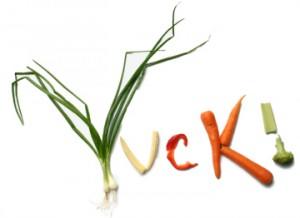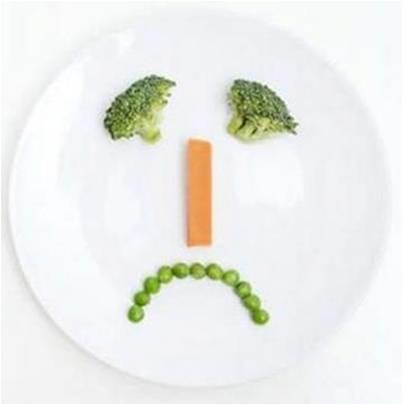After years of working with clients on diet and fitness, I rarely encounter an issue that I don’t have at least a semi-reasonable fix for. But this one continues to stump me time and time again: What in the heck am I supposed to do with clients who flat out don’t like healthy food?
Does the thought of eating something green make you want to gag? More often than not, the “yucky” culprits are vegetables, but I’ve also had my fair share of those who don’t like fruit, whole grains, beans, dairy, nuts, or anything that resembles healthy fare. Yikes!
Actually, many Americans don’t like healthy food. Only 26% of adults report eating vegetables the recommended three or more times per day, and even those who report eating fruits and vegetables might not exactly be munching on apples and spinach. According to one report, orange juice is the top source of fruit among U.S. adults and adolescents, and potatoes are the favorite vegetable.
 According to the experts, our poor choices likely reflect our lack of understanding of what makes a healthy diet in the first place, the easy availability of the wrong things, and perhaps our lack of knowledge about how to prepare food that’s better for us. While I believe all of this to be true, we can’t ignore the simple reality that, for most people, healthy food just doesn’t taste as good.
According to the experts, our poor choices likely reflect our lack of understanding of what makes a healthy diet in the first place, the easy availability of the wrong things, and perhaps our lack of knowledge about how to prepare food that’s better for us. While I believe all of this to be true, we can’t ignore the simple reality that, for most people, healthy food just doesn’t taste as good.
Raw food expert, Robert Ross, blames this sad fact on sugar:
“One of the main culprits is sugar. Today there is some sort of sweetener in absolutely every food that is commercially prepared…in things that don’t even taste sweet. It is all about creating an addiction…because addicts are the best customers of all. And now that your taste for sweets has been properly programmed, the natural taste of nutrient dense organic vegetables won’t satisfy your sweet tooth…vegetables may taste bitter or nasty to you.”
Ross goes on to give 12 strategies for people who hate vegetables:
- Make a commitment to change. To start out you have to make a decision, a commitment, to change, accepting that it will be difficult at first.
- Re-train your taste buds. By weaning yourself off of the things that confuse your taste buds, like artificial flavors and sweeteners, your taste buds can begin to return to normal – and eventually actually develop the ability to enjoy – the natural taste of healthy foods.
- Learn why not all vegetables are considered equal. The taste of a vegetable changes drastically depending on how it’s cooked.
- Stick with your program. In this age of processed foods and sugar-addictions, the poor vegetable can’t possibly have the appeal of a chemically-processed burger that’s been field-tested by marketing and psychology experts who know all your buttons. Making a transition to real, whole food isn’t going to happen overnight. So once you get past your initial disappointment in your vegetables, keep eating them anyway. Eventually, you’ll begin to appreciate them, and then even really desire them. But you must stick with the program.
- Eat your veggies with other foods. When you get started, try masking the initial taste of vegetables. For example, a salad dressing you like will make your salad go down easier.
- Drink your veggies! Juice bars are popping up all over, providing a fresh, tasty alternative to eating vegetables. Keep in mind that some commercial juices include additives like sugar, flavorings or even dairy products. Juiced veggies also don’t have the fiber you get from their whole counterparts.
- Transform your veggies into sauces, soups, toppings and garnishes. Tomato sauce, some salad dressings, and salsas are just a few of the recipes you can find for making vegetables more palatable. Top a pizza with fresh broccoli or cauliflower – don’t knock it til you try it!
- Try Something You Haven’t Had Before. Many people don’t eat vegetables because they’ve
 never tried anything other than peas and carrots. Try something new–you never know what you may discover. Sure, you’re bored with tomatoes, potatoes and iceberg lettuce–so give eggplant or arugula a try! All have very different textures and flavors and are full of nutrients.
never tried anything other than peas and carrots. Try something new–you never know what you may discover. Sure, you’re bored with tomatoes, potatoes and iceberg lettuce–so give eggplant or arugula a try! All have very different textures and flavors and are full of nutrients. - Stick with Raw. Many raw vegetables make great snacks just by adding hummus, salad dressings and salsa. Keep them ready for quick easy access by cleaning them when you get back from the store.
- Eat from the Rainbow. When you think about vegetables, you probably think green. But vegetables come in a wide variety of colors, from red to purple, yellow to orange. Each color brings a whole new set of vitamins, minerals and flavors to your table.
- Eat Seasonally. Fresh, in-season, locally grown vegetables offer the most flavor and nutrition. For example, asparagus is ideal in the spring. Arugula, corn and tomatoes are best in the summer. Broccoli, eggplant and pumpkins reach their peak in the fall. For a complete list of in-season produce, download our Free Meal Planner in the sidebar on this page.
- Grow them yourself. Try growing some vegetables in your own organic garden. It’s very hard not to like vegetables that you grew yourself. In the end, you may find out that you actually don’t hate vegetables, you just hate them prepared in the ways you’ve always tried them. So give some new recipes – you might surprise yourself.
Need more motivation? Check out these insights from other experts…
Here’s what scientist and foodie, Darya Pino, PhD, of Summer Tomato has to say about it:
“Even if a certain food doesn’t end up on your favorites list, learning to at least enjoy it in a casual way will enrich your life and help you develop an appreciation for new and unique experiences…The key word here is “enjoy.” Eating vegetables is undeniably healthy, but the best reason to eat broccoli is that you absolutely love it.”
Evelyn Tribole, MS, RD, co-author of Stealth Health: How to Sneak Nutrition Painlessly Into Your Diet, recommends evaluating your favorite foods to figure out where you can make smart substitutions with foods that may not be on the top of your list:
“If you love tuna noodle casserole, crab cakes or fish patties, substitute salmon for the seafood…You can crumble it [tofu] on chili, slice it thin in lasagna, or puree it and use it to replace half the cream cheese in recipes. Tofu is an excellent example of adding good nutrition without realizing a taste change.”
Writer, Kate Brennan, is a big fan of experimentation:
“As an adult, you have choices to make about the foods you eat and how you want to approach your health. Eating a variety of fruits, vegetables, whole grains and lean proteins is key for a healthy life. But these foods don’t have to be boring or tasteless. Experiment with new varieties and preparation techniques. Explore the farmers market or an ethnic grocery store. Challenge yourself to try a new vegetable each month. As you broaden your horizons, you may also broaden your palate.”


